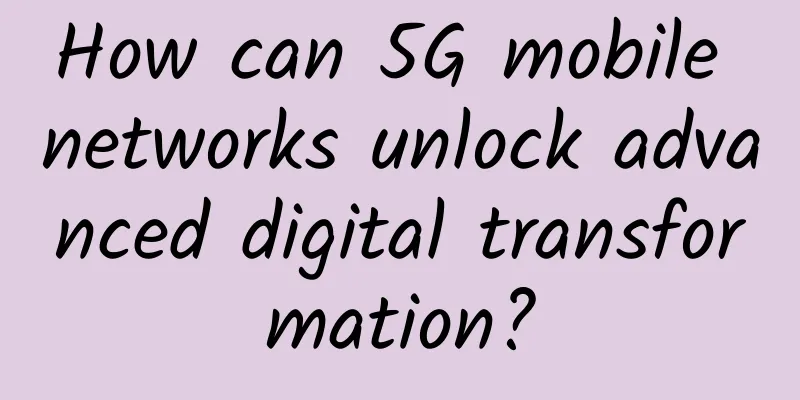How can 5G mobile networks unlock advanced digital transformation?

As businesses and the public sector embrace digital transformation, we are on the brink of a major change that highlights a simple fact: there can be no advanced digitalization without high-performance mobile connectivity. In the next 5 to 10 years, three interdependent cross-industry trends, electrification, automation and digitalization, will accelerate. The potential to realize these trends depends on three connected technologies: mobility, cloud and artificial intelligence. Under the combined effect of these technologies, efficiency and productivity will be improved, while digital, user-friendly services will be realized, immersive experiences and more sustainable solutions will emerge. Neither the cloud nor AI can truly scale without mobile technology. That’s why it’s so important to fully implement the next wave of advanced connectivity, especially the extraordinary capabilities of 5G. Similar to previous technological changes that digitized consumers and drove the rapid expansion of the app economy, the next wave of mobile technology will unleash innovation across industries, reshape businesses, and unlock new network value. Making the next wave of mobility a reality The way we build mobile networks has undergone a fundamental shift in recent years. Ericsson is building open, programmable networks that are resilient, energy efficient and ensure a superior user experience in terms of availability, reliability and speed. At the same time, programmable networks can be managed through software, allowing for rapid changes and flexible control over how the network operates and what services can be launched. This enables faster, more secure and differentiated connectivity, essentially priority-based service levels, providing tailored solutions for each enterprise or government customer. We are also changing the way innovators, entrepreneurs and businesses take advantage of unique network capabilities. While the mobile web is by far the largest platform in the world, it only operates in a single direction, from the network to the user. We want to enable bidirectional operation so that developers can interact with the network and innovate with unique network capabilities. This fundamental shift is driven by network APIs. These standardized interfaces enable mobile networks and applications to communicate with each other and enable developers to call specific network resources such as quality of service, speed, latency and location with simple commands. Our goal is to see millions of developers experiment, innovate and build game-changing applications using 5G technology. Last year, we announced new partnerships with some of the world’s largest telecom operators. They will open up their networks to easily access advanced network capabilities through a global platform that aggregates network APIs. This will enable new use cases in areas we can’t even imagine, such as banking, logistics, manufacturing, and more. The real-life impact of advanced connectivity Today, many industries use proprietary solutions and lack a single connectivity technology foundation. This limits economies of scale, such as slowing down efficiency gains and cost reductions. Some areas where our standardized network can transform the industry include private networks, networks for first responders, and connectivity to satellites (known as non-terrestrial networks). Combined with network APIs and other innovations, these new networks will enable manufacturers to redesign production processes, retailers to use cellular as the primary access technology in all locations, and emergency and information services to be available in every corner of the world. We have seen these productivity gains firsthand in our 5G-connected factories in Texas, where the application of new technologies such as digital twins has doubled labor productivity. Here are three use cases for mobile network innovation:
The companies, countries and regions that lead the way in 5G today will be the economic and political powerhouses of the future, as they will reap the lion’s share of the fruits of innovation. Just as railroads catalyzed industrialization, next-generation mobile networks will reshape the economic and political landscape and drive sustainable growth. China and the United States thrived in the consumer platform economy because they were the first countries to build nationwide 4G networks. India, the United States, China, and parts of the Middle East are already well ahead in the 5G era. For example, China has deployed more than 10,000 private networks to digitize enterprises and achieve significant productivity gains. India is also doubling down on 5G construction, deploying more than one million 5G base stations in a year. On the other hand, Europe has fallen behind and now faces a far-reaching choice - either continue on the path of leading the world in regulation or start competing on innovation and technology such as 5G. I believe digitalization will accelerate, and the telecom industry has a once-in-a-generation opportunity to transform society on a global scale. Countries face a big choice. Do they commit to technological leadership, or do they sit on the sidelines? Whether in business, government or telecommunications, collectively moving away from the old ways of working can be challenging. But as my father always said, "When was the best time to plant a tree? 40 years ago. When was the second best time? Today. Start now." |
<<: How does Google never go down?
>>: Kitchen air conditioning is really not an IQ tax
Recommend
The most comprehensive mind map: How to trigger user growth?
In fact, user growth systems are very common in o...
A woman was hospitalized after eating raw pickles. Be careful when making your own raw pickles! It can cause diarrhea at the mildest and poisoning at the worst.
Recently, there was a trending search #Woman lear...
Dragon Boat Festival Marketing Activities Guide!
Holidays have always been important marketing nod...
Taobao Art Training Camp for Beginners
Course Catalog: ├──【Software Course】Photoshop res...
Vipshop product operation analysis!
Vipshop is positioned as "a website speciali...
Why are 16-megapixel mobile phone photos not as good as iPhone?
The image quality of digital cameras is a commonp...
up to date! Ranking of data rise and fall of 43 information flow platforms!
The latest traffic rankings of major information ...
How to use multiple windows on Android? An Android multi-window tool with a size of only 1M
We know that Android can handle multiple tasks at...
Scientists finally uncover the secret of the mysterious fruit that changes human taste
There is a small fruit in the world that can turn...
E-book project that can easily earn 30,000+ yuan a month, operation process from 0 to monetization, proven to be effective
Course Description Many times, some inconspicuous...
Wu Hanqing’s personal profile: How to discover high-quality external link resources?
Baidu is now paying more and more attention to th...
This winter "seasonal fruit" is available online, but many people have a "fear of buying"? Teach you how to choose →
Winter is coming, and it is the best time to eat ...
Why Microsoft's cloud computing business is losing to Amazon
When Microsoft released its latest financial repo...
Among the insects you caught as a child, there was probably this little butterfly.
When I was young, I loved all kinds of insects. O...
Money psychology, teach you how to achieve financial freedom course video
Are you fanatically pursuing those low-priced pro...









